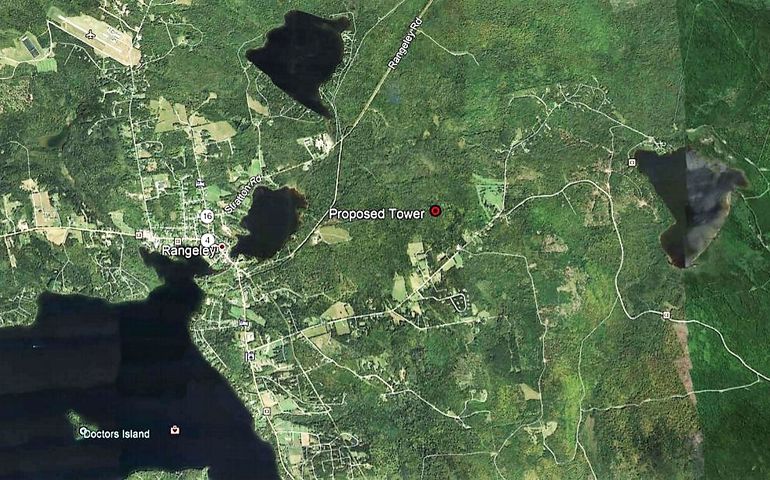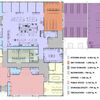Processing Your Payment
Please do not leave this page until complete. This can take a few moments.
- News
-
Editions
View Digital Editions
Biweekly Issues
- December 1, 2025
- Nov. 17, 2025
- November 03, 2025
- October 20, 2025
- October 6, 2025
- September 22, 2025
- + More
Special Editions
- Lists
- Viewpoints
-
Our Events
Event Info
Award Honorees
- Calendar
- Biz Marketplace
Proposed 300-foot cell tower near Rangeley draws criticism after earlier failed attempt
 Courtesy / Maine Land Use Planning Commission
A satellite image shows the location of a proposed 300-foot-tall cellphone tower, in Dallas Plantation, near Rangeley Village. Saddleback Mountain, not shown, is about 6 miles to the east of the tower site.
Courtesy / Maine Land Use Planning Commission
A satellite image shows the location of a proposed 300-foot-tall cellphone tower, in Dallas Plantation, near Rangeley Village. Saddleback Mountain, not shown, is about 6 miles to the east of the tower site.
A proposal to erect a 300-foot-tall cellphone tower in rural Franklin County gets a public hearing Tuesday after six months of planning — and two years after a proposal for a smaller tower there failed.
The Maine Land Use Planning Commission is scheduled to receive testimony in a hearing on the new project, which would construct the tower and a half-mile access road in Dallas Plantation, about 5 miles east of Rangeley.
Portland-based Rising Tide Towers LLC hopes to build the lighted, lattice-style structure under contract with AT&T Inc. and the federal FirstNet program, a $40 billion initiative to expand wireless telecommunication networks for use by first responders. Maine joined the effort in 2017, and the program soon identified a “significant gap in service coverage” in Dallas Plantation.
But in October 2019 the commission rejected Rising Tide’s initial attempt to site a 190-foot-high tower on a nearby parcel of land, saying the structure was incompatible with local residential zoning. Both that site and the new one are leased from a local landowner, Mark Beauregard.
The LUPC, a division of the state’s Department of Agriculture, Forestry and Conservation, oversees planning for over 10 million acres of unorganized territories in the state, including Dallas Plantation.
In March, Rising Tide returned to the commission with a new approach — siting the tower in a different zone that wouldn’t require the structure to be compatible with residential uses.
But while the original site was on Dallas Hill, at an elevation of 2,013 feet, the new location is 150 feet lower. To provide the necessary wireless coverage at that level, Rising Tide and AT&T say, the proposed tower must now be at least 300 feet tall.
The original plan drew sharp criticism from area residents, and the new one seems to have attracted its own share of negative reaction.
In May, the commission said it had received 24 public comments in response to the proposal, and all but two were opposed to it. Among the concerns cited was the visual impact of the structure and its aircraft-warning beacon, which would flash at night.
Since May, other comments have echoed the original criticism.
“The previous plan was rejected because the project was located too close to residential and recreational property. It appears to me that the new location is not significantly different from the last plan. The adjustments really make no significant, practical difference from the rejected Site,” wrote one Dallas Plantation resident, John Margolis, in public comments to the LUPC.
The commission hearing is scheduled for Tuesday at 6 p.m., at the Sugarloaf Mountain Hotel, in Carrabassett Valley. The commission will also accept written comments through Sept. 17.
More information can be found here.
Mainebiz web partners

The Giving Guide
The Giving Guide helps nonprofits have the opportunity to showcase and differentiate their organizations so that businesses better understand how they can contribute to a nonprofit’s mission and work.
Learn More
Work for ME
Work for ME is a workforce development tool to help Maine’s employers target Maine’s emerging workforce. Work for ME highlights each industry, its impact on Maine’s economy, the jobs available to entry-level workers, the training and education needed to get a career started.
Learn More
Groundbreaking Maine
Whether you’re a developer, financer, architect, or industry enthusiast, Groundbreaking Maine is crafted to be your go-to source for valuable insights in Maine’s real estate and construction community.
Learn more-
The Giving Guide
The Giving Guide helps nonprofits have the opportunity to showcase and differentiate their organizations so that businesses better understand how they can contribute to a nonprofit’s mission and work.
-
Work for ME
Work for ME is a workforce development tool to help Maine’s employers target Maine’s emerging workforce. Work for ME highlights each industry, its impact on Maine’s economy, the jobs available to entry-level workers, the training and education needed to get a career started.
-
Groundbreaking Maine
Whether you’re a developer, financer, architect, or industry enthusiast, Groundbreaking Maine is crafted to be your go-to source for valuable insights in Maine’s real estate and construction community.
ABOUT
NEW ENGLAND BUSINESS MEDIA SITES
No articles left
Get access now
In order to use this feature, we need some information from you. You can also login or register for a free account.
By clicking submit you are agreeing to our cookie usage and Privacy Policy
Already have an account? Login
Already have an account? Login
Want to create an account? Register
Get access now
In order to use this feature, we need some information from you. You can also login or register for a free account.
By clicking submit you are agreeing to our cookie usage and Privacy Policy
Already have an account? Login
Already have an account? Login
Want to create an account? Register







0 Comments